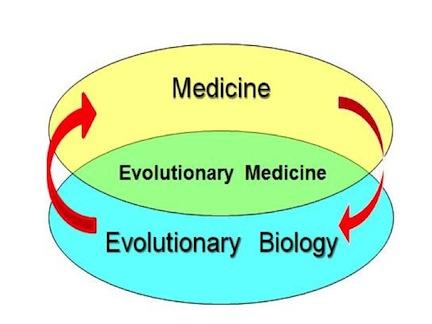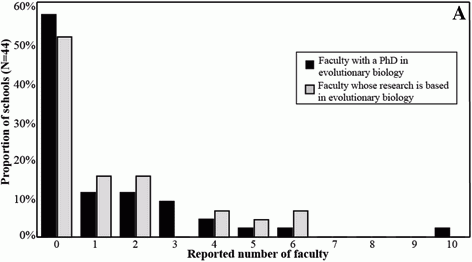What is Evolutionary Medicine: Ten Questions Answered
What is Evolutionary Medicine: Ten Questions Answered
What is Evolutionary Medicine: Ten Questions Answered
1. What is evolutionary medicine?
How I look forward to the day when no one needs to ask! Evolutionary medicine, sometimes called Darwinian medicine, is the field at the intersection of evolution and medicine. Evolution AND Medicine is a better descriptor, but that has not caught on. The field uses the basic science of evolutionary biology to find ways to prevent and treat disease, and it uses studies of disease to advance basic evolutionary biology(2).

2. What isn’t evolutionary medicine?
Evolutionary medicine is not radical or alternative. It is not a special kind of medical practice. It does not advocate any particular kind of diet, exercise, or treatment. It does not make direct clinical recommendations based on theory alone (3). If your doctor claims to practice evolutionary medicine, be sure that treatment recommendations are based on controlled scientific studies; if they come directly from theory, find a better doctor. Evolutionary medicine is standard mainstream medical science, appropriately cautious about making clinical recommendations.
3. How does evolutionary medicine transform our understanding of disease?
Evolutionary medicine poses a fundamentally new kind of question about disease. Instead of only asking how bodies work and why some people get sick, evolutionary medicine also asks why natural selection has left all of us with traits that make us vulnerable to disease (1). Why do we have wisdom teeth, narrow coronary arteries, a narrow birth canal, and a food passage that crosses the windpipe? Evolution explains why we have traits that leave us vulnerable to disease, as well as why so many other aspects of the body work so well. For instance, the usual question about back pain is why it afflicts some individuals. Evolutionary medicine also asks why back problems have been a problem for all hominid species since they first walked on two legs.

4. Is evolutionary medicine mainly about diseases caused by our modern environments?
Most chronic disease results because our bodies are poorly prepared to stay healthy in modern environments(4), but this is only one of several evolutionary explanations for why we get sick(5). Vulnerability to infections persists because pathogens evolve so quickly. Not all deleterious mutations can be eliminated because there are limits to what natural selection can do. Other vulnerabilities result from inevitable tradeoffs, including the big one of maximizing reproduction even when that harms health. Also, selection has shaped many defenses, such as inflammation, whose utility comes at a substantial cost in tissue damage and suffering. These are not alternatives to standard medical explanations, they are complementary deeper explanations.
5. Is evolutionary medicine only about vulnerabilities?
No, questions about vulnerability are only one part of evolutionary medicine. Some scientists use DNA evidence to trace the evolutionary history of humans and pathogens. Some use evolution to discover new ways to prevent resistance to antibiotics and cancer chemotherapy drugs. Others study why selection cannot remove some genetic variations that cause disease. Evolutionary medicine includes all aspects of evolutionary biology applied to all problems in medicine and public health.
6. Evolutionary medicine shows how diseases are useful, right?
Wrong. Diseases are not adaptations shaped by selection. There is nothing useful about pneumonia, schizophrenia, epilepsy, or cancer. Trying to understand diseases as if they are adaptations is a mistake, one that is unfortunately as common as it is serious (6). However, many symptoms of disease, such as pain, fever, vomiting, cough, and fatigue, are adaptations. The systems that regulate such defenses are, for good evolutionary reasons, prone to failures that cause chronic pain, anxiety disorders, and many other diseases.
7. Is evolutionary medicine useful?
It sure is! Some applications are relatively direct — doctors who understand how selection shaped regulation mechanisms can make better decisions about when it is safe to use drugs to block fever and cough(2,3). However, like genetics and microbiology, evolution is a basic science that mainly provides new understanding that lead to new treatments(1,7,8). Evolutionary models that analyze the evolutionary competition between cells in a malignancy have led to new chemotherapy strategies that greatly extend the lives of mice with cancer(9). Models of antibiotic resistance suggest that “take every pill in the bottle” may be bad advice(10). We must find out what in our modern environment is causing the new epidemic of autoimmune diseases like diabetes, multiple sclerosis, and Crohn’s disease(11).
8. Don’t most doctors already know all about evolution?
No, most doctors would likely fail the midterm in an introductory evolution class(13,14). Even medical leaders often have gross misconceptions. A famous geneticist once suggested at a big Darwin meeting that selection keeps mutations happening for the good of the species, an idea has been recognized as a mistake for 50 years. The belief that long association with a host makes viruses milder remains common among physicians, decades after Paul Ewald and others pointed out that selection maximizes transmission of pathogens even if that kills the host. Engineers learn the principles of thermodynamics so they don’t make mistakes like trying to build perpetual motion machines. Doctors never learn the principles of evolutionary biology, so major misconceptions persist in medicine(15).
9. Why don’t medical schools teach evolution the same way they teach other sciences?
Most medical schools have no evolutionary biologists on faculty, few doctors who know much about evolution, and some who think bodies are products of intelligent design. Even the core idea that evolutionary explanations are needed to complement descriptions of mechanisms is unfamiliar to most doctors. Some display their naiveté of methods for testing evolutionary hypotheses by spouting the phrase “just so stories,” as if that is a devastating critique. Some actually teach “just so stories.” That evolution in the medical curriculum remains in the 19th century is shameful.

Figure from Hdaka et al. 2015 BMC Medical Education
10. How long will it take for medicine and public health to make full use of evolutionary biology?
Progress is now rapid(16). The International Society for Evolution, Medicine and Public Health has created a network of evolutionarily sophisticated researchers, educators, and clinicians, and new education resources, including EvMedEd.org. Several new textbooks are available (8,17,18) along with a new journal, Evolution, Medicine, & Public Health, and The Evolution and Medicine Review. The evolution questions recently added to medical school entrance examinations are spurring enrollment in evolution courses. Students who have taken an undergraduate evolutionary medicine course are arriving at medical school full of new questions. They will grow up to be medical school deans. When they do, evolutionary biology will finally be recognized widely as an essential basic science for medicine.
Literature Cited
1. Nesse RM, Williams GC. Why we get sick : the new science of Darwinian medicine. 1st Vintage Books. New York: Vintage Books; 1996. xi, 290 p.
2. Nesse RM, Stearns SC. The great opportunity: Evolutionary applications to medicine and public health. Evol Appl. 2008;1(1):28–48.
3. Nesse RM. Ten questions for evolutionary studies of disease vulnerability. Evol Appl [Internet]. 2011;4(2):264–77. Available from: http://dx.doi.org/10.1111/j.1752-4571.2010.00181.x
4. Gluckman PD, Hanson M. Mismatch: why our world no longer fits our bodies. New York: Oxford University Press, USA; 2006.
5. Nesse RM. Maladaptation and natural selection. Q Rev Biol [Internet]. 2005 Mar;80(1):62–70. Available from: http://www.ncbi.nlm.nih.gov/pubmed/15884737
6. Nesse RM. Ten questions for evolutionary studies of disease vulnerability. Evol Appl [Internet]. 2011;4(2):264–77. Available from: http://dx.doi.org/10.1111/j.1752-4571.2010.00181.x
7. Stearns SC. Evolutionary medicine: its scope, interest and potential. Proc Biol Sci [Internet]. 2012 Nov 7;279(1746):4305–21. Available from: http://www.ncbi.nlm.nih.gov/pubmed/22933370
8. Stearns SC, Medzhitov R. Evolutionary medicine. Sunderland, MA: Sinauer Associates, Inc., Publishers; 2016.
9. Gatenby RA, Silva AS, Gillies RJ, Frieden BR. Adaptive therapy. Cancer Res [Internet]. 2009 [cited 2016 Jun 3];69(11):4894–903. Available from: http://cancerres.aacrjournals.org/content/69/11/4894.short
10. Read AF, Day T, Huijben S. The evolution of drug resistance and the curious orthodoxy of aggressive chemotherapy. Proc Natl Acad Sci. 2011;108(Supplement 2):10871–7.
11. Blaser MJ. Missing microbes: how the overuse of antibiotics is fueling our modern plagues [Internet]. Macmillan; 2014 [cited 2016 Jun 3]. Available from: https://books.google.com/books?hl=en&lr=lang_en&id=iB5OAwAAQBAJ&oi=fnd&p...
12. Nesse RM. Natural Selection and the Regulation of Defenses: A Signal Detection Analysis of the Smoke Detector Principle. Evol Hum Behav. 2005;26:88–105.
13. Nesse RM, Schiffman JD. Evolutionary Biology in the Medical School Curriculum. Bioscience. 2003;53(6):585–7.
14. Hidaka BH, Asghar A, Aktipis CA, Nesse RM, Wolpaw TM, Skursky NK, et al. The status of evolutionary medicine education in North American medical schools. BMC Med Educ [Internet]. 2015 [cited 2016 Feb 1];15(1):1. Available from: http://bmcmededuc.biomedcentral.com/articles/10.1186/s12909-015-0322-5
15. Antolin MF, Jenkins KP, Bergstrom CT, Crespi BJ, De S, Hancock A, et al. Evolution and medicine in undergraduate education: a prescription for all biology students. Evolution [Internet]. 2012 Jun;66(6):1991–2006. Available from: http://www.ncbi.nlm.nih.gov/pubmed/22671563
16. Nesse RM, Bergstrom CT, Ellison PT, Flier JS, Gluckman P, Govindaraju DR, et al. Making evolutionary biology a basic science for medicine. Proc Natl Acad Sci USA [Internet]. 2010 Jan 26;107 Suppl 1:1800–7. Available from: www.pnas.org/cgi/doi/10.1073/pnas.0906224106
17. Perlman RL. Evolution and medicine. First edition. Oxford, United Kingdom: Oxford University Press; 2013. 162 p.
18. Gluckman P, Beedle A, Hanson M. Principles of Evolutionary Medicine. Oxford, UK: Oxford University Press; 2009.
19. Kruger DJ, Nesse RM. An Evolutionary Life-History Framework for Understanding Sex Differences in Human Mortality Rates. Hum Nat. 2006;17(1):74–97.
20. Nesse RM. Tinbergen’s four questions, organized: a response to Bateson and Laland. Trends Ecol Evol [Internet]. 2013 Dec;28(12):681–2. Available from: http://www.ncbi.nlm.nih.gov/pubmed/24216179

